2009 HYUNDAI TUCSON warning
[x] Cancel search: warningPage 33 of 273
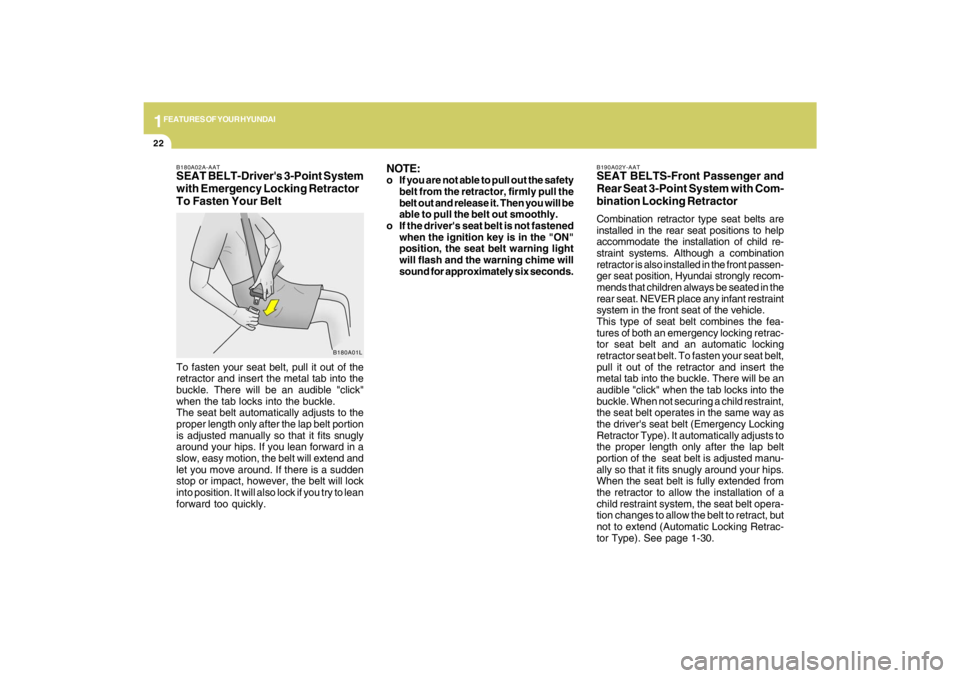
1FEATURES OF YOUR HYUNDAI22
B190A02Y-AATSEAT BELTS-Front Passenger and
Rear Seat 3-Point System with Com-
bination Locking RetractorCombination retractor type seat belts are
installed in the rear seat positions to help
accommodate the installation of child re-
straint systems. Although a combination
retractor is also installed in the front passen-
ger seat position, Hyundai strongly recom-
mends that children always be seated in the
rear seat. NEVER place any infant restraint
system in the front seat of the vehicle.
This type of seat belt combines the fea-
tures of both an emergency locking retrac-
tor seat belt and an automatic locking
retractor seat belt. To fasten your seat belt,
pull it out of the retractor and insert the
metal tab into the buckle. There will be an
audible "click" when the tab locks into the
buckle. When not securing a child restraint,
the seat belt operates in the same way as
the driver's seat belt (Emergency Locking
Retractor Type). It automatically adjusts to
the proper length only after the lap belt
portion of the seat belt is adjusted manu-
ally so that it fits snugly around your hips.
When the seat belt is fully extended from
the retractor to allow the installation of a
child restraint system, the seat belt opera-
tion changes to allow the belt to retract, but
not to extend (Automatic Locking Retrac-
tor Type). See page 1-30. To fasten your seat belt, pull it out of the
retractor and insert the metal tab into the
buckle. There will be an audible "click"
when the tab locks into the buckle.
The seat belt automatically adjusts to the
proper length only after the lap belt portion
is adjusted manually so that it fits snugly
around your hips. If you lean forward in a
slow, easy motion, the belt will extend and
let you move around. If there is a sudden
stop or impact, however, the belt will lock
into position. It will also lock if you try to lean
forward too quickly.
B180A02A-AATSEAT BELT-Driver's 3-Point System
with Emergency Locking Retractor
To Fasten Your Belt
B180A01L
NOTE:o If you are not able to pull out the safety
belt from the retractor, firmly pull the
belt out and release it. Then you will be
able to pull the belt out smoothly.
o If the driver's seat belt is not fastened
when the ignition key is in the "ON"
position, the seat belt warning light
will flash and the warning chime will
sound for approximately six seconds.
Page 34 of 273
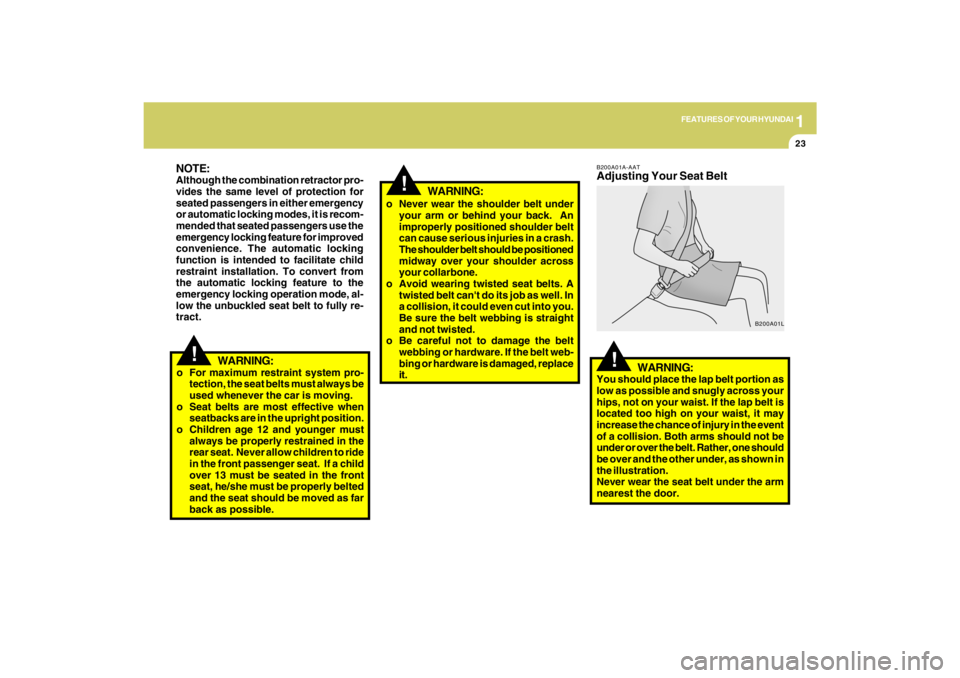
1
FEATURES OF YOUR HYUNDAI
23
!
NOTE:Although the combination retractor pro-
vides the same level of protection for
seated passengers in either emergency
or automatic locking modes, it is recom-
mended that seated passengers use the
emergency locking feature for improved
convenience. The automatic locking
function is intended to facilitate child
restraint installation. To convert from
the automatic locking feature to the
emergency locking operation mode, al-
low the unbuckled seat belt to fully re-
tract.
WARNING:
o For maximum restraint system pro-
tection, the seat belts must always be
used whenever the car is moving.
o Seat belts are most effective when
seatbacks are in the upright position.
o Children age 12 and younger must
always be properly restrained in the
rear seat. Never allow children to ride
in the front passenger seat. If a child
over 13 must be seated in the front
seat, he/she must be properly belted
and the seat should be moved as far
back as possible.
o Never wear the shoulder belt under
your arm or behind your back. An
improperly positioned shoulder belt
can cause serious injuries in a crash.
The shoulder belt should be positioned
midway over your shoulder across
your collarbone.
o Avoid wearing twisted seat belts. A
twisted belt can't do its job as well. In
a collision, it could even cut into you.
Be sure the belt webbing is straight
and not twisted.
o Be careful not to damage the belt
webbing or hardware. If the belt web-
bing or hardware is damaged, replace
it.
!
WARNING:
You should place the lap belt portion as
low as possible and snugly across your
hips, not on your waist. If the lap belt is
located too high on your waist, it may
increase the chance of injury in the event
of a collision. Both arms should not be
under or over the belt. Rather, one should
be over and the other under, as shown in
the illustration.
Never wear the seat belt under the arm
nearest the door.
!
B200A01A-AATAdjusting Your Seat Belt
B200A01L
WARNING:
Page 35 of 273
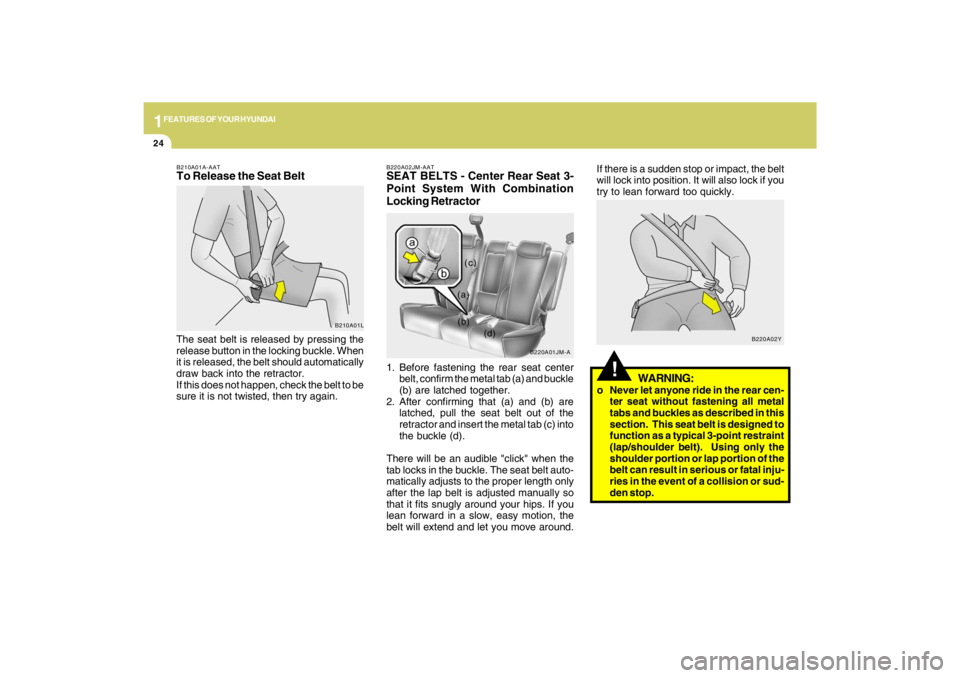
1FEATURES OF YOUR HYUNDAI24
!
WARNING:
o Never let anyone ride in the rear cen-
ter seat without fastening all metal
tabs and buckles as described in this
section. This seat belt is designed to
function as a typical 3-point restraint
(lap/shoulder belt). Using only the
shoulder portion or lap portion of the
belt can result in serious or fatal inju-
ries in the event of a collision or sud-
den stop.
B220A02JM-AATSEAT BELTS - Center Rear Seat 3-
Point System With Combination
Locking Retractor1. Before fastening the rear seat center
belt, confirm the metal tab (a) and buckle
(b) are latched together.
2. After confirming that (a) and (b) are
latched, pull the seat belt out of the
retractor and insert the metal tab (c) into
the buckle (d).
There will be an audible "click" when the
tab locks in the buckle. The seat belt auto-
matically adjusts to the proper length only
after the lap belt is adjusted manually so
that it fits snugly around your hips. If you
lean forward in a slow, easy motion, the
belt will extend and let you move around.If there is a sudden stop or impact, the belt
will lock into position. It will also lock if you
try to lean forward too quickly.
(d)
B220A02Y
B220A01JM-A
(c)
The seat belt is released by pressing the
release button in the locking buckle. When
it is released, the belt should automatically
draw back into the retractor.
If this does not happen, check the belt to be
sure it is not twisted, then try again.B210A01A-AATTo Release the Seat Belt
B210A01L
(a)
(b)
Page 36 of 273
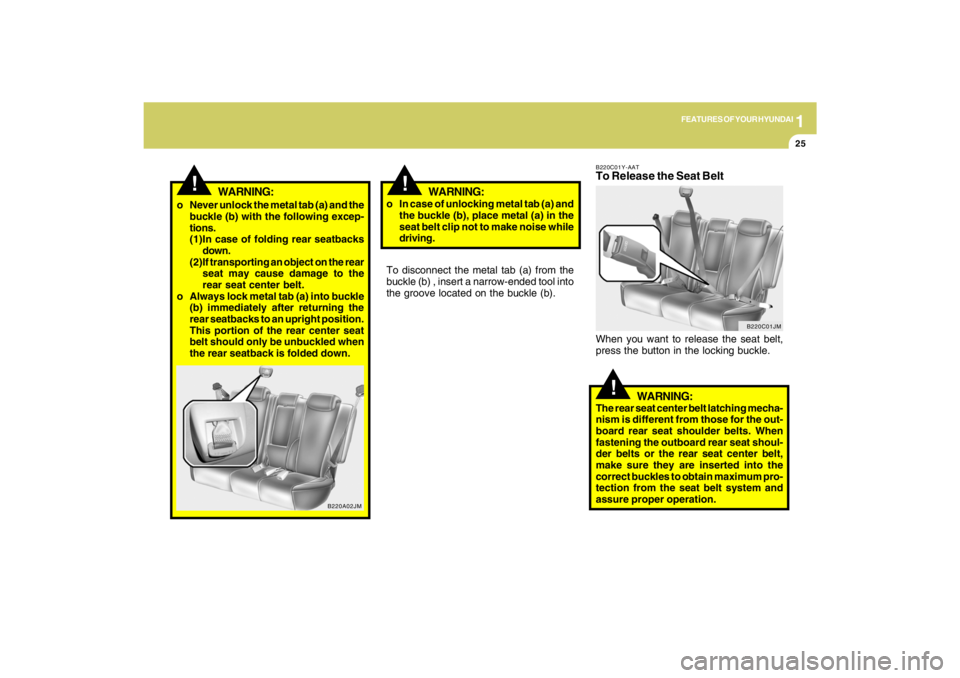
1
FEATURES OF YOUR HYUNDAI
25
!
WARNING:
!
o Never unlock the metal tab (a) and the
buckle (b) with the following excep-
tions.
(1)In case of folding rear seatbacks
down.
(2)If transporting an object on the rear
seat may cause damage to the
rear seat center belt.
o Always lock metal tab (a) into buckle
(b) immediately after returning the
rear seatbacks to an upright position.
This portion of the rear center seat
belt should only be unbuckled when
the rear seatback is folded down.
WARNING:
!
B220C01Y-AATTo Release the Seat BeltWhen you want to release the seat belt,
press the button in the locking buckle.
WARNING:
The rear seat center belt latching mecha-
nism is different from those for the out-
board rear seat shoulder belts. When
fastening the outboard rear seat shoul-
der belts or the rear seat center belt,
make sure they are inserted into the
correct buckles to obtain maximum pro-
tection from the seat belt system and
assure proper operation.
B220C01JM
B220A02JM
o In case of unlocking metal tab (a) and
the buckle (b), place metal (a) in the
seat belt clip not to make noise while
driving.
To disconnect the metal tab (a) from the
buckle (b) , insert a narrow-ended tool into
the groove located on the buckle (b).
Page 37 of 273
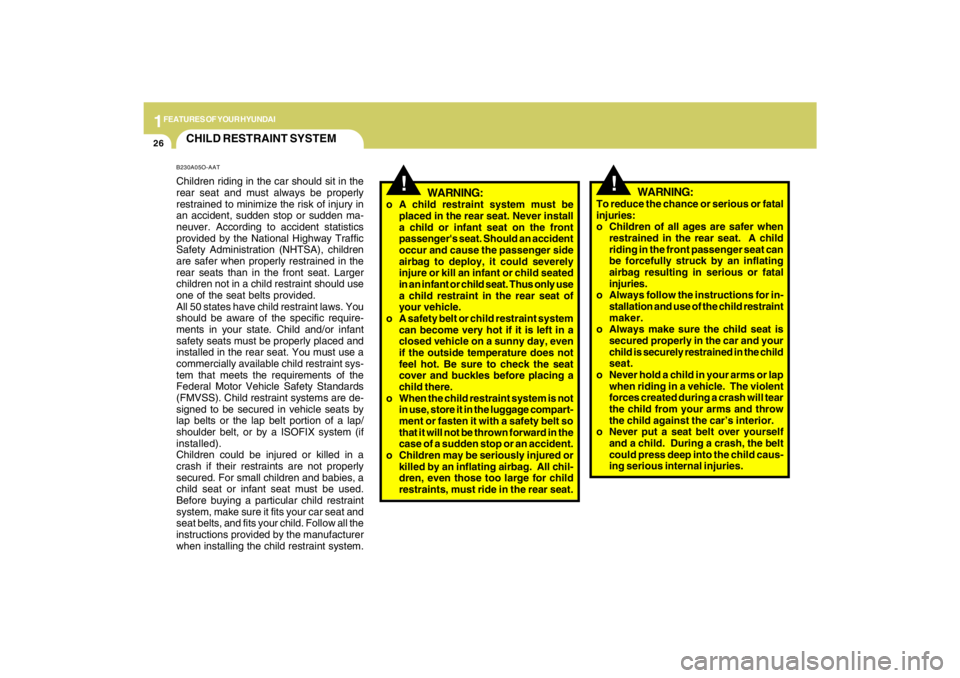
1FEATURES OF YOUR HYUNDAI26
CHILD RESTRAINT SYSTEMB230A05O-AATChildren riding in the car should sit in the
rear seat and must always be properly
restrained to minimize the risk of injury in
an accident, sudden stop or sudden ma-
neuver. According to accident statistics
provided by the National Highway Traffic
Safety Administration (NHTSA), children
are safer when properly restrained in the
rear seats than in the front seat. Larger
children not in a child restraint should use
one of the seat belts provided.
All 50 states have child restraint laws. You
should be aware of the specific require-
ments in your state. Child and/or infant
safety seats must be properly placed and
installed in the rear seat. You must use a
commercially available child restraint sys-
tem that meets the requirements of the
Federal Motor Vehicle Safety Standards
(FMVSS). Child restraint systems are de-
signed to be secured in vehicle seats by
lap belts or the lap belt portion of a lap/
shoulder belt, or by a ISOFIX system (if
installed).
Children could be injured or killed in a
crash if their restraints are not properly
secured. For small children and babies, a
child seat or infant seat must be used.
Before buying a particular child restraint
system, make sure it fits your car seat and
seat belts, and fits your child. Follow all the
instructions provided by the manufacturer
when installing the child restraint system.
WARNING:
To reduce the chance or serious or fatal
injuries:
o Children of all ages are safer when
restrained in the rear seat. A child
riding in the front passenger seat can
be forcefully struck by an inflating
airbag resulting in serious or fatal
injuries.
o Always follow the instructions for in-
stallation and use of the child restraint
maker.
o Always make sure the child seat is
secured properly in the car and your
child is securely restrained in the child
seat.
o Never hold a child in your arms or lap
when riding in a vehicle. The violent
forces created during a crash will tear
the child from your arms and throw
the child against the car’s interior.
o Never put a seat belt over yourself
and a child. During a crash, the belt
could press deep into the child caus-
ing serious internal injuries.
!
!
WARNING:
o A child restraint system must be
placed in the rear seat. Never install
a child or infant seat on the front
passenger's seat. Should an accident
occur and cause the passenger side
airbag to deploy, it could severely
injure or kill an infant or child seated
in an infant or child seat. Thus only use
a child restraint in the rear seat of
your vehicle.
o A safety belt or child restraint system
can become very hot if it is left in a
closed vehicle on a sunny day, even
if the outside temperature does not
feel hot. Be sure to check the seat
cover and buckles before placing a
child there.
o When the child restraint system is not
in use, store it in the luggage compart-
ment or fasten it with a safety belt so
that it will not be thrown forward in the
case of a sudden stop or an accident.
o Children may be seriously injured or
killed by an inflating airbag. All chil-
dren, even those too large for child
restraints, must ride in the rear seat.
Page 38 of 273
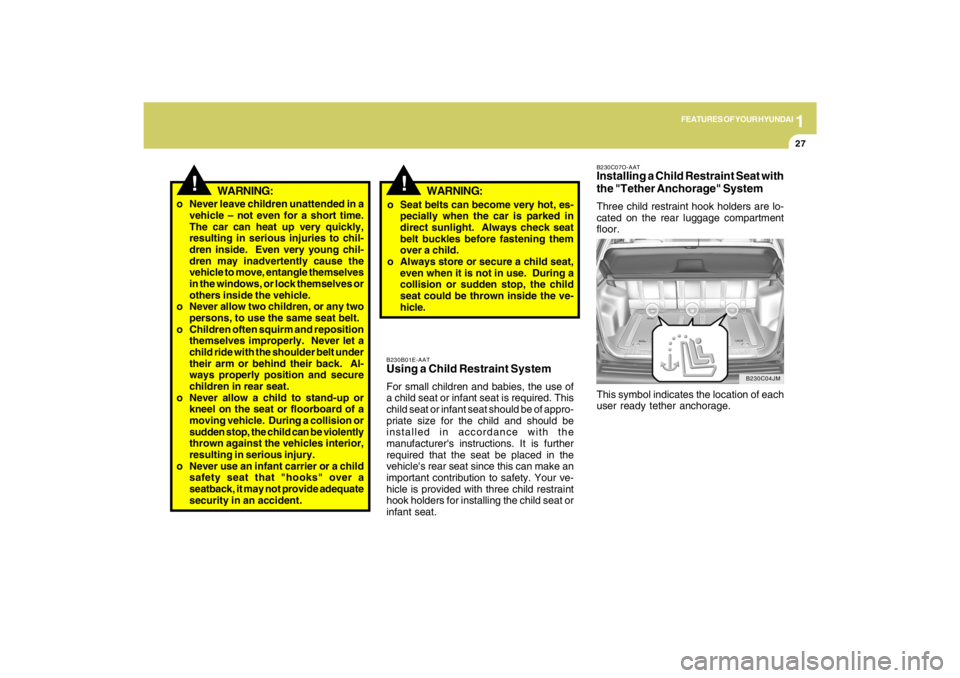
1
FEATURES OF YOUR HYUNDAI
27
B230C07O-AATInstalling a Child Restraint Seat with
the "Tether Anchorage" SystemThree child restraint hook holders are lo-
cated on the rear luggage compartment
floor.
This symbol indicates the location of each
user ready tether anchorage.
B230C04JM B230B01E-AAT
Using a Child Restraint SystemFor small children and babies, the use of
a child seat or infant seat is required. This
child seat or infant seat should be of appro-
priate size for the child and should be
installed in accordance with the
manufacturer's instructions. It is further
required that the seat be placed in the
vehicle's rear seat since this can make an
important contribution to safety. Your ve-
hicle is provided with three child restraint
hook holders for installing the child seat or
infant seat.
!
o Never leave children unattended in a
vehicle – not even for a short time.
The car can heat up very quickly,
resulting in serious injuries to chil-
dren inside. Even very young chil-
dren may inadvertently cause the
vehicle to move, entangle themselves
in the windows, or lock themselves or
others inside the vehicle.
o Never allow two children, or any two
persons, to use the same seat belt.
o Children often squirm and reposition
themselves improperly. Never let a
child ride with the shoulder belt under
their arm or behind their back. Al-
ways properly position and secure
children in rear seat.
o Never allow a child to stand-up or
kneel on the seat or floorboard of a
moving vehicle. During a collision or
sudden stop, the child can be violently
thrown against the vehicles interior,
resulting in serious injury.
o Never use an infant carrier or a child
safety seat that "hooks" over a
seatback, it may not provide adequate
security in an accident.
WARNING:
!
WARNING:
o Seat belts can become very hot, es-
pecially when the car is parked in
direct sunlight. Always check seat
belt buckles before fastening them
over a child.
o Always store or secure a child seat,
even when it is not in use. During a
collision or sudden stop, the child
seat could be thrown inside the ve-
hicle.
Page 39 of 273
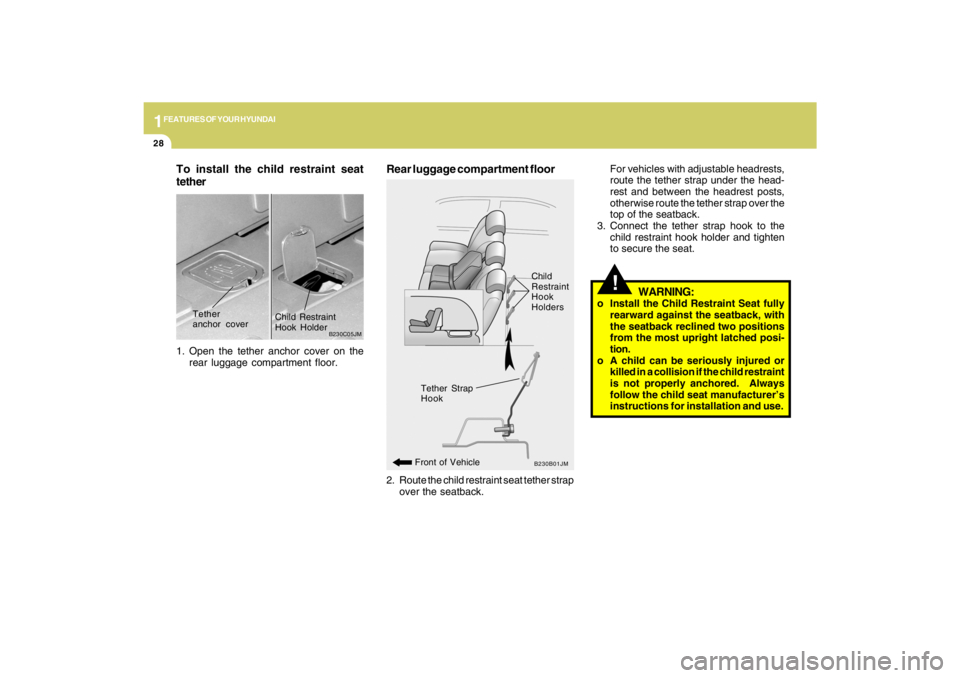
1FEATURES OF YOUR HYUNDAI28
To install the child restraint seat
tether1. Open the tether anchor cover on the
rear luggage compartment floor.
B230C05JM
Tether
anchor coverChild Restraint
Hook Holder
2. Route the child restraint seat tether strap
over the seatback.Rear luggage compartment floor
B230B01JM
Front of VehicleChild
Restraint
Hook
Holders
Tether Strap
Hook
!For vehicles with adjustable headrests,
route the tether strap under the head-
rest and between the headrest posts,
otherwise route the tether strap over the
top of the seatback.
3. Connect the tether strap hook to the
child restraint hook holder and tighten
to secure the seat.
WARNING:
o Install the Child Restraint Seat fully
rearward against the seatback, with
the seatback reclined two positions
from the most upright latched posi-
tion.
o A child can be seriously injured or
killed in a collision if the child restraint
is not properly anchored. Always
follow the child seat manufacturer’s
instructions for installation and use.
Page 40 of 273
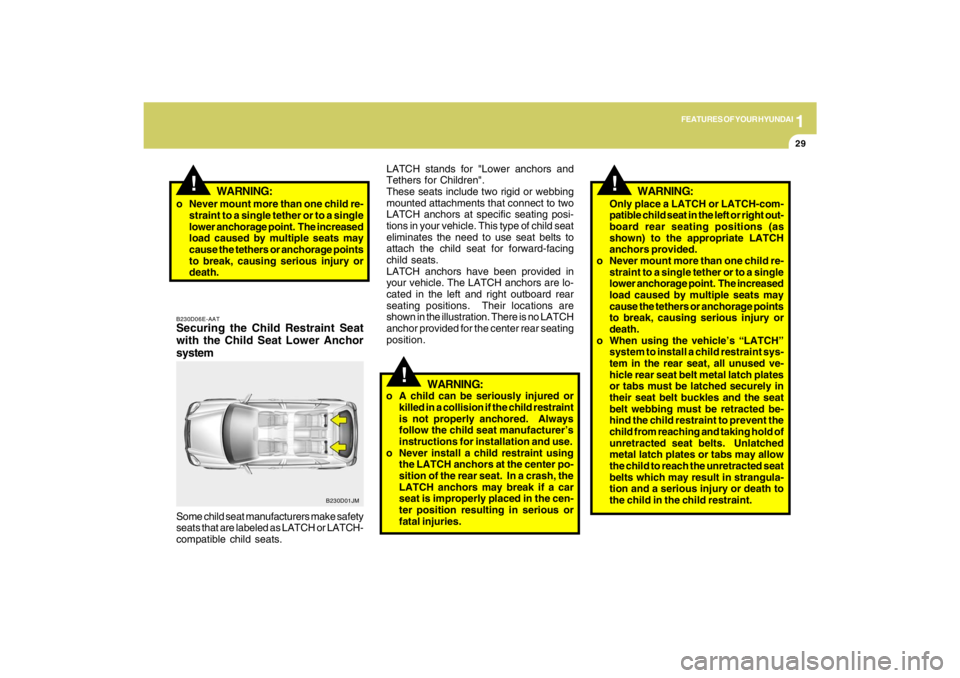
1
FEATURES OF YOUR HYUNDAI
29
!
WARNING:
!Only place a LATCH or LATCH-com-
patible child seat in the left or right out-
board rear seating positions (as
shown) to the appropriate LATCH
anchors provided.
o Never mount more than one child re-
straint to a single tether or to a single
lower anchorage point. The increased
load caused by multiple seats may
cause the tethers or anchorage points
to break, causing serious injury or
death.
o When using the vehicle’s “LATCH”
system to install a child restraint sys-
tem in the rear seat, all unused ve-
hicle rear seat belt metal latch plates
or tabs must be latched securely in
their seat belt buckles and the seat
belt webbing must be retracted be-
hind the child restraint to prevent the
child from reaching and taking hold of
unretracted seat belts. Unlatched
metal latch plates or tabs may allow
the child to reach the unretracted seat
belts which may result in strangula-
tion and a serious injury or death to
the child in the child restraint.
!
WARNING:
o A child can be seriously injured or
killed in a collision if the child restraint
is not properly anchored. Always
follow the child seat manufacturer’s
instructions for installation and use.
o Never install a child restraint using
the LATCH anchors at the center po-
sition of the rear seat. In a crash, the
LATCH anchors may break if a car
seat is improperly placed in the cen-
ter position resulting in serious or
fatal injuries.
B230D06E-AATSecuring the Child Restraint Seat
with the Child Seat Lower Anchor
systemSome child seat manufacturers make safety
seats that are labeled as LATCH or LATCH-
compatible child seats.
B230D01JM
WARNING:
o Never mount more than one child re-
straint to a single tether or to a single
lower anchorage point. The increased
load caused by multiple seats may
cause the tethers or anchorage points
to break, causing serious injury or
death.LATCH stands for "Lower anchors and
Tethers for Children".
These seats include two rigid or webbing
mounted attachments that connect to two
LATCH anchors at specific seating posi-
tions in your vehicle. This type of child seat
eliminates the need to use seat belts to
attach the child seat for forward-facing
child seats.
LATCH anchors have been provided in
your vehicle. The LATCH anchors are lo-
cated in the left and right outboard rear
seating positions. Their locations are
shown in the illustration. There is no LATCH
anchor provided for the center rear seating
position.